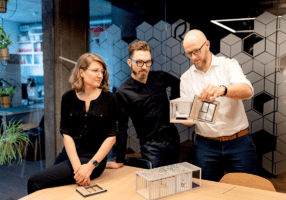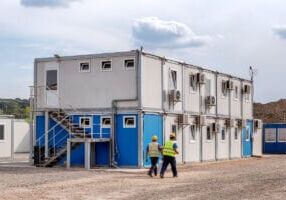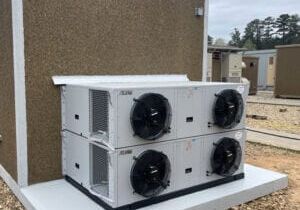Structural versus Cyclical: What Matters More?
Economic Transformation Meets the Business Cycle

Anirban Basu is the Chairman & CEO of Sage Policy Group and Chief Economist of the Modular Building Institute.
Leo Tolstoy’s acclaimed novel Anna Karenina opens with the famous line, “All happy families are alike; each unhappy family is unhappy in its own way.” Something similar can be said for the various segments that comprise the U.S. construction industry. Those segments that have dominated construction spending growth in recent years share a common feature – they benefit from dramatic economic transformations that generate a need to significantly alter the built environment. By contrast, segments that have not prospered generally have category-specific reasons for their malaise.
There are several structural transformations impacting the U.S. economy that stand to drive construction spending higher even if interest rates stay elevated for longer and the economy enters a mild recession. At the top of that list is construction related to manufacturing. For decades, supply chains were relocated from America to a bevy of nations offering lower wages, more relaxed regulatory environments, investment in supporting infrastructure, and rapidly expanding industrial workforces. The mantra among many American manufacturing CEOs appears to have been that as a profit maximizing enterprise, one must also be a cost minimizer, and minimizing costs means manufacturing beyond American boundaries.

Anirban Basu speaks at the Modular Building Institute's annual World of Modular conference.
But now a new set of considerations have induced leaders of major global manufacturing enterprises to reconsider their site selection decisions. Among these are:
- a desire for simpler logistics emphasizing shorter transit distances and times;
- a need to better protect intellectual property;
- more reliable court systems;
- incentives offered by the USMCA, America’s trade deal with Canada and Mexico; and
- a recent set of subsidies offered under packages like the Chips and Science Act and the Inflation Reduction Act.
What’s more, certain advantages offered by other nations have been diminished by time. As indicated by Deloitte analysts, labor cost pressures in the U.S. and Western Europe “are being mitigated by advances in robotics and automation.” Meanwhile, Chinese wages have been ramping higher, increasing 83 percent over the past decade.
The impact on the U.S. construction industry has been nothing short of mind-bending. Between February 2020 and November 2023, total nonresidential construction spending in America expanded 29 percent (not adjusting for inflation). Meanwhile, construction spending in the manufacturing segment grew 168 percent.
Importantly, this is not a cyclical phenomenon. In fact, by one prominent measure (the Institute for Supply Management’s Purchasing Managers Index), the U.S. manufacturing sector had been in recession for 14 consecutive months through December 2023. Nonetheless, manufacturing related construction volumes have continued to edge skyward as structural factors predominate.
Structural factors are impacting several other segments as well. Among them are data centers, driven in part by the growing pervasiveness of artificial intelligence, healthcare facilities, supported by an aging population and rising healthcare utilization, and infrastructure, promoted by an abundance of federal support spawning from legislation passed in 2021.
According to CBRE, data center supply in primary markets expanded by nearly 492 megawatts or 12 percent during the first half of 2023 compared to the latter half of 2022. On a year-over-year basis, supply expanded by 19 percent. More data centers are on the way. According to the same source, “an all-time high of 2,287.6 MW was under construction in primary markets”, representing a 25 percent year-over-year increase.
For modular builders and other industry stakeholders, these structural dynamics are of consequence, or at least they should be. For the better part of two years, contractors and others involved in interest rate sensitive economic segments have fretted about the impact of higher rates and possible recession. At the time of this writing, interest rates are still high despite expectations that the Federal Reserve will begin to loosen monetary policy later in 2024 and in 2025. Risk of recession remains. But the structural transformations transpiring in the economy signify that some construction segments stand to continue to expand even if the U.S. economy enters a period of downturn at some point this year or next.
There are, of course, some real estate and construction segments that are negatively impacted by structural changes. Among these changes are the specter of remote work, business meetings conducted on various online platforms, and e-commerce. While e-commerce has helped spawn an industrial space boom in America as Amazon and others have developed a need for additional fulfillment center space, demand for shopping center space has been compromised. During the 1980s there were around 2,500 mall locations in America. By the early parts of the current decade, that figure had declined to around 700. A Wall Street Journal article quoted expert Nick Egelanian, president of retail consulting firm Site Works, who indicated that roughly a decade from now that figure could be down to 150. Such trends have obvious implications for retail construction.
Hotels catering to business travelers have also been impacted by newly emerging behaviors. Conducting business meetings, including the delivery of economic forecast presentations, via online platforms has become far more common. While leisure travel came back with a vengeance during the pandemic recovery period, business travel did not. Not coincidentally, among nonresidential construction’s sixteen segments, no segment has experienced as much spending decline as lodging.
And then there is the office market. This is a market that has also been negatively impacted by structural changes, and tends to suffer greatly during periods of recession. Despite U.S. economic and employment growth last year, the national office vacancy rate continued to rise. As lease renewals continue over the next several years, vacancy stands to climb. There is also a debt maturity wall, meaning that many building owners will have to refinance their debt into higher interest debt during the years ahead. In many instances, building owners are likely to hand their keys over to the bank as building valuations slip below balances owed. Among other things, that will translate into more difficult project financing for office space developers.
In the final analysis, modular builders will want to align themselves with relevant economic segments that stand to benefit from structural economic shifts. There are a few of them set to create prospective opportunities for contractors to support deal flow even if the broader economy enters its next downturn at some point in the near-term.
More from Modular Advantage
How Rebel Concept Harnesses AI as a Design Tool to Improve the DFMA Process
“The complexity of projects and the size of project are so large, and the technology is so complicated that AI would do it so much faster than we are,” says Kris Droszcz, CEO at Rebel Concept. “Everybody’s struggling to control the manufacturing processes according to the design. And I think that’s what AI will do.”
One Answer from AI Can Provide Innumerable Opportunities, says Stack Modular’s Jim Dunn
The Stack AI Engine is not fully functional yet, but it offers an unlimited number of productivity benefits. Currently, the company is using AI for cost estimates, most recently for a project out in California.
GrayWolf: Building the Future of Modular Data Centers to Power the AI Revolution
The growth of artificial intelligence (AI) and cloud-based applications has created an urgent need for data centers capable of managing massive amounts of data. As businesses across industries increasingly rely on digital infrastructure to power their AI tools, the demand for data centers has skyrocketed.
Artificial Intelligence: Yes, it is a Construction Game-Changer
Much like other sectors of the economy, AI is reshaping construction, revolutionizing how projects are planned and executed across the country. While it is obvious that AI cannot do certain things by itself, like laying bricks, paving roads, or shingling roofs, its impact stands to be both massive and positive.
The Potential and Possibilities of AI for Offsite
AI is everywhere. Many industries have incorporated AI into business as usual with new organizational structures and new dependencies to be more efficient and to automate repetitive tasks. Offsite construction will not be immune to AI’s ubiquity. The technology offers unique benefits to the offsite building process.
Moving from AI Hype to an AI Advantage
Learning about AI will help you see past the overinflated hype and identify the opportunities specific to your own business. Learning about AI is like peeling an onion – each layer reveals something new, and occasionally it might make your eyes water. But in the end, you’ll have all the ingredients you need to cook up some real innovation in your organization.
The Blueprint for Smart and Ethical AI Integration in Your Business
The journey toward smart and ethical AI integration involves crafting a strategic vision that aligns AI’s transformative potential with your organizational goals. True success with AI is measured by its capacity to enhance human capabilities, foster sustainable growth, and generate value for all stakeholders while actively avoiding ethical pitfalls and harmful risks.
Five Factors for Success When Shifting Your Business to Modular
As labor, competitive and cost factors push more contractors and developers to embrace the opportunity to go modular as a first choice and not a last resort, it’s become clear that adopting this new model requires more than just a willingness to make it happen. Here are five factors to consider as your company moves to a modular construction model:
UniCool-Edge: Optimized Cooling Solutions for Modular and Edge Data Centers
In an industry where efficiency, scalability, and security are crucial, the UniCool-Edge™ system is a revolutionary solution for modular data center manufacturers. By offering external mounting for maximum space utilization, energy-efficient cooling, and pre-commissioned reliability, UniCool-Edge helps manufacturers stay ahead in the rapidly evolving AI-driven data center market. As edge data centers continue to expand, solutions like UniCool-Edge will play a vital role in supporting the next generation of modular data centers and their data center infrastructure.
Building Skills in a Virtual World: Immersive Training for the Modern Workforce
As both the hardware and software for developing and deploying XR applications continue to become more affordable, the investment in this technology as a training tool is increasingly appealing. XR also offers several other benefits, including performing potentially hazardous tasks in a safe environment and acquiring new skills without the immediate need for physical materials.










